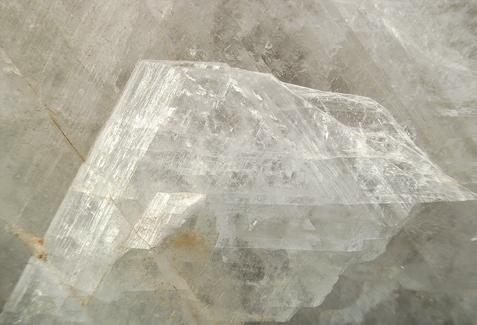FSU geologist explores minerals below Earth's surface

Assistant Professor Mainak Mookherjee found that the mineral feldspar became softer under extreme pressure. Credit: Mainak Mookherjee
A Florida State University geology researcher is going deep below the Earth's surface to understand how some of the most abundant minerals that comprise the Earth's crust change under pressure.
In a paper published today in Scientific Reports, Assistant Professor of Geology Mainak Mookherjee explores how feldspar, one of the most important minerals in the Earth's crust, changes under pressure. Typically, materials become stiffer when pressure is applied, but Mookherjee found that these pale-colored crystals actually become softer under extreme pressures.
“I am interested in exploring these materials at extreme conditions,” Mookherjee said. “Feldspar is very abundant in the earth's crust so we need to understand its elastic property.”
Mookherjee's work shows that at a depth of about 30 kilometers from the Earth's surface, feldspar decomposes to denser mineral phases such as pyroxene and quartz. The densification of feldspar could partially explain a scientific observation called seismic discontinuity across the Earth's crust and mantle.
This seismic discontinuity, also called Mohorovicic discontinuity, is the boundary between the Earth's crust and mantle. It was first observed in 1909 by a Croatian scientist Andrija Mohorovicic who realized that seismograms from shallow-focus earthquakes had two sets of waves — one that followed a direct path near the Earth's surface, i.e., crust, and the other arriving faster and probably refracted from the underlying higher-velocity medium mantle.
“This is the first study of the elastic properties of feldspar at high pressure,” Mookherjee said. “And it provides very new insight and a novel way of accounting for the sharp Mohorovicic discontinuity.”
Scientists have been working since the late 1950s to understand the Mohorovicic discontinuity that separates the Earth's outermost layer — oceanic and continental crust — with the underlying mantle. Last year, researchers from the drill ship JOIDES Resolution made attempts to drill a bore hole across the discontinuity, but fell short. Further drilling attempts are planned for future.
“We care about the mineral structures in the deep Earth and how they transform to denser crystal structures within the Earth,” Mookherjee said. “Through a thorough understanding of the atomic scale structures at extreme conditions and how they influence the properties of the Earth materials, it is possible to gain valuable insight into deep Earth dynamics.”
###
Mookherjee did his work through computer simulations at the FSU Research Computing Center and facilities at Argonne National Laboratory. The research was funded by the National Science Foundation.
Other researchers contributing to the article are Dhenu Patel, a Tallahassee high school student who interned in Mookherjee's lab last summer; Olle Heinonen from Argonne National Laboratory; Anant Hariharan from Cornell University; Ketan Maheshwari from University of Pittsburgh; and David Mainprice from Université de Montpellier.
Media Contact
All latest news from the category: Earth Sciences
Earth Sciences (also referred to as Geosciences), which deals with basic issues surrounding our planet, plays a vital role in the area of energy and raw materials supply.
Earth Sciences comprises subjects such as geology, geography, geological informatics, paleontology, mineralogy, petrography, crystallography, geophysics, geodesy, glaciology, cartography, photogrammetry, meteorology and seismology, early-warning systems, earthquake research and polar research.
Newest articles

Superradiant atoms could push the boundaries of how precisely time can be measured
Superradiant atoms can help us measure time more precisely than ever. In a new study, researchers from the University of Copenhagen present a new method for measuring the time interval,…

Ion thermoelectric conversion devices for near room temperature
The electrode sheet of the thermoelectric device consists of ionic hydrogel, which is sandwiched between the electrodes to form, and the Prussian blue on the electrode undergoes a redox reaction…

Zap Energy achieves 37-million-degree temperatures in a compact device
New publication reports record electron temperatures for a small-scale, sheared-flow-stabilized Z-pinch fusion device. In the nine decades since humans first produced fusion reactions, only a few fusion technologies have demonstrated…





















